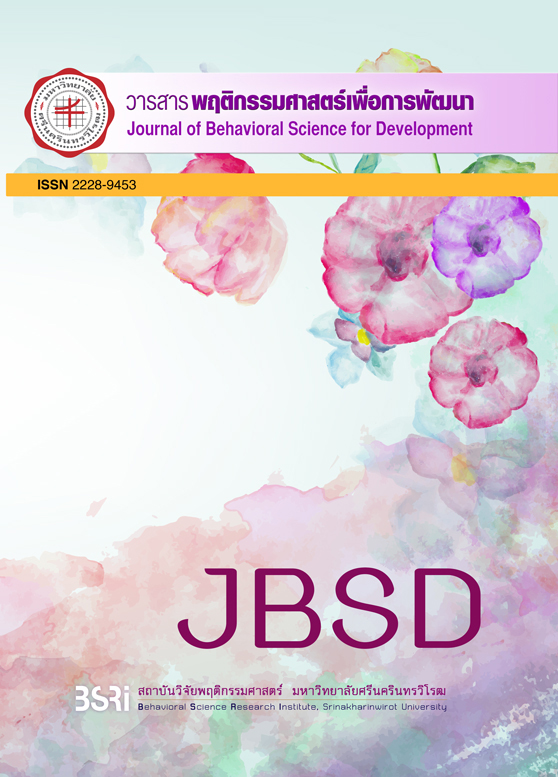Efficiency of ML, WLSMV and Bayesian Parameter Estimation Methods for Non-normality Ordered Categorical Data in Difference Condition: Case Study of the First Order Confirmatory Factor Analysis
Abstract
ประสิทธิภาพของวิธีการประมาณค่าพารามิเตอร์แบบ ML, WLSMV และ Bayesian สำหรับข้อมูลจำแนกกลุ่มแบบเรียงอันดับ ที่มีการแจกแจงไม่เป็นโค้งปกติ ภายใต้เงื่อนไขที่แตกต่างกัน: กรณีการวิเคราะห์องค์ประกอบเชิงยืนยันลำดับแรก
Abstract
The objective of this research was to examine and compare the efficiency of 4 different parameter estimation methods consisted: ML (in case of transformed and non transformed data to normal distribution) via WLSMV and Bayesian for non-normality ordered categorical data under 4 different sample sizes (80, 160, 370 and 623). This research used 10,000 pseudo populations. The comparisons were done involving 16 conditions and each condition was replicated 200 times. The dependent variables evaluated consisted of: 1) the bias of parameter estimates; 2) the bias of standard errors; 3) construct reliability () and average variance extracted (); and 4) Model fit indices to determine percent of model fit. The research findings revealed that: 1) The parameter estimates of Bayesian and WLSMV estimations becoming closer to true parameters when sample size increased. Both estimation methods were found to be trivial biased of parameter estimates and standard errors when sample size increased to at least 370. ML estimations (both transformed and non transformed data to normal distribution) were found to be substantial biased of parameter estimates and standard errors. The parameter estimates were underestimated with .001 statistical significant levels 2) Construct reliability () and average variance extracted () of measurement model of Bayesian estimation were not different from true parameters for all sample sizes. Both values of WLSMV estimation were not different from true parameters when sample size increased to at least 160. ML estimations (both transformed and non transformed data to normal distribution) were found to be underestimated with .001 statistical significant levels for all sample sizes. 3) WLSMV estimation ended up being more acceptable than the other estimations for all sample sizes. Bayesian estimation was accurate when the sample size increased to at least 370. ML estimations (both transformed and non transformed data to normal distribution) were less accurate than WLSMV and Bayesian estimation. The percentages of model fit were found to increase with the sample size increased for all parameter estimations.
Keywords: Parameter Estimation Methods, ML, WLSMV, Bayesian, Ordered Categorical Data, Non-Normality Distribution
บทคัดย่อ
การวิจัยครั้งนี้มีวัตถุประสงค์เพื่อศึกษาและเปรียบเทียบประสิทธิภาพของวิธีประมาณค่าพารามิเตอร์ 4 แบบของโมเดลการวิเคราะห์องค์ประกอบเชิงยืนยันลำดับแรก ได้แก่ วิธีการ ML ในกรณีที่มีและไม่มีการเปลี่ยนรูปข้อมูลให้มีการแจกแจงเป็นโค้งปกติ วิธีการ WLSMV และวิธีการ Bayesian เมื่อข้อมูลการวัดอยู่ในมาตรวัดจำแนกกลุ่มแบบเรียงอันดับที่มีการแจกแจงไม่เป็นโค้งปกติ ภายใต้ขนาดกลุ่มตัวอย่างที่ต่างกัน 4 ขนาด ได้แก่ ขนาด 80, 160, 370 และ 623 โดยใช้การสุ่มตัวอย่างซ้ำจากข้อมูลประชากรเทียม 10,000 หน่วย ภายใต้ 16 เงื่อนไข เงื่อนไขละ 200 ครั้ง เพื่อศึกษา 1) ค่าความเอนเอียงของค่าประมาณพารามิเตอร์ 2) ค่าความเอนเอียงของค่าคลาดเคลื่อนมาตรฐาน 3) ค่าความเชื่อมั่นของตัวแปรแฝงและค่าเฉลี่ยความแปรปรวนที่ถูกสกัดได้ของโมเดลการวัด และ 4) ร้อยละของโมเดลที่สอดคล้องกับข้อมูลเชิงประจักษ์ โดยพิจารณาจากดัชนีวัดความสอดคล้องกลมกลืนของโมเดล ผลการวิจัย พบว่า 1) ค่าประมาณพารามิเตอร์ที่ได้จากวิธีการ Bayesian และ WLSMV จะมีค่าใกล้เคียงกับค่าจริงของพารามิเตอร์มากขึ้นเมื่อขนาดกลุ่มตัวอย่างเพิ่มขึ้น โดยจะให้ค่าความเอนเอียงของค่าประมาณพารามิเตอร์ในระดับต่ำ เมื่อใช้ขนาดกลุ่มตัวอย่างตั้งแต่ 370 ขึ้นไป ส่วนวิธีการ ML ทั้งสองกรณีจะให้ค่าความเอนเอียงอยู่ในระดับสูง และค่าประมาณพารามิเตอร์มีค่าต่ำกว่าค่าจริงของพารามิเตอร์อย่างมีนัยสำคัญทางสถิติที่ระดับ .001 2) ค่าความเชื่อมั่นของตัวแปรแฝง () และค่าเฉลี่ยของความแปรปรวนที่สกัดได้ () ของโมเดลการวัด จากวิธีการ Bayesian มีค่าไม่แตกต่างกับค่าจริงของพารามิเตอร์ ในทุกขนาดกลุ่มตัวอย่าง ในขณะที่วิธีการ WLSMV จะให้ค่า และ ของโมเดลการวัดไม่แตกต่างกับค่าจริงของพารามิเตอร์ เมื่อใช้ขนาดกลุ่มตัวอย่างตั้งแต่ 160 ขึ้นไป ส่วนวิธีการ ML ทั้งสองกรณีจะให้ค่า ค่า และ ของโมเดลการวัดต่ำกว่าค่าจริงของพารามิเตอร์ อย่างมีนัยสำคัญทางสถิติที่ระดับ .001 ในทุกขนาดกลุ่มตัวอย่าง 3) วิธีการ WLSMV จะให้ผลการทดสอบความสอดคล้องของโมเดลที่ดีที่สุดในทุกขนาดตัวอย่าง ในขณะที่วิธีการ Bayesian ให้ผลการทดสอบความสอดคล้องของโมเดลที่ดีที่สุดเมื่อใช้กลุ่มตัวอย่างขนาดตั้งแต่ 370 ขึ้นไป ในขณะที่วิธีการ ML ทั้งสองกรณีจะมีโอกาสผ่านเกณฑ์ความสอดคล้องน้อยกว่าวิธีการ WLSMV และ Bayesian ซึ่งร้อยละของโมเดลที่สอดคล้องกับข้อมูลเชิงประจักษ์จะเพิ่มขึ้นตามขนาดของกลุ่มตัวอย่างในทุกวิธีการ
คำสำคัญ: การประมาณค่าพารามิเตอร์, ML, WLSMV, Bayesian, ข้อมูลจำแนกกลุ่มแบบเรียงอันดับ,การแจกแจงไม่เป็นโค้งปกติ, การวิเคราะห์องค์ประกอบเชิงยืนยันลำดับแรก


